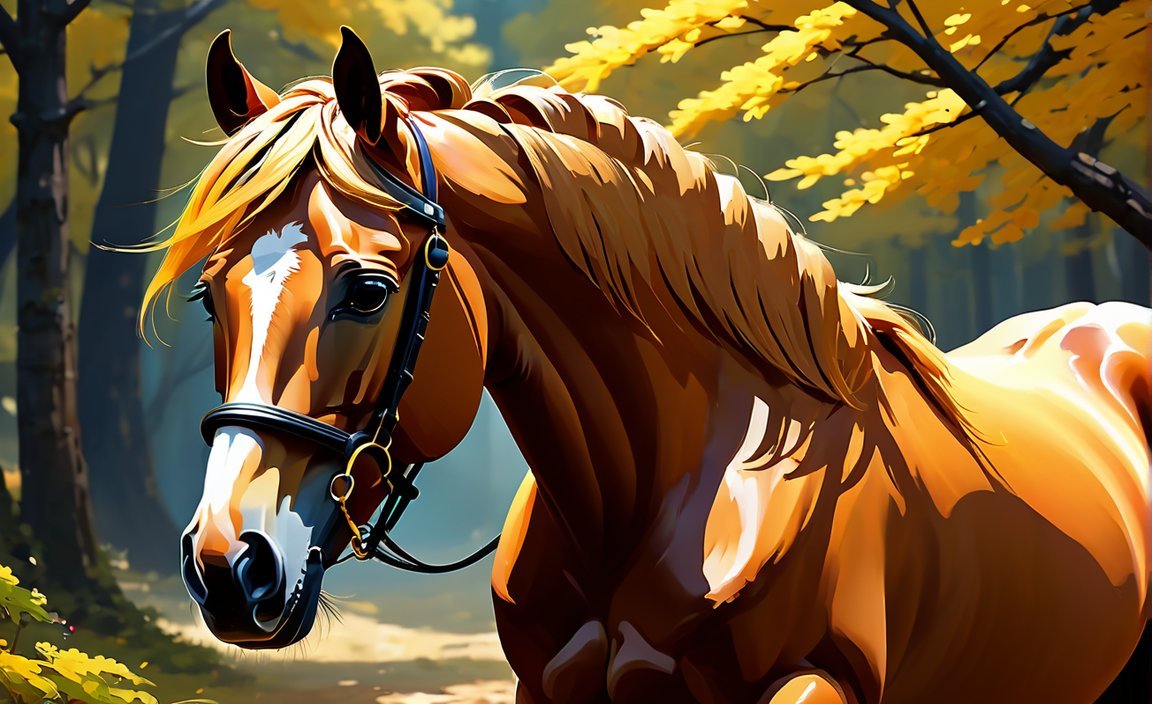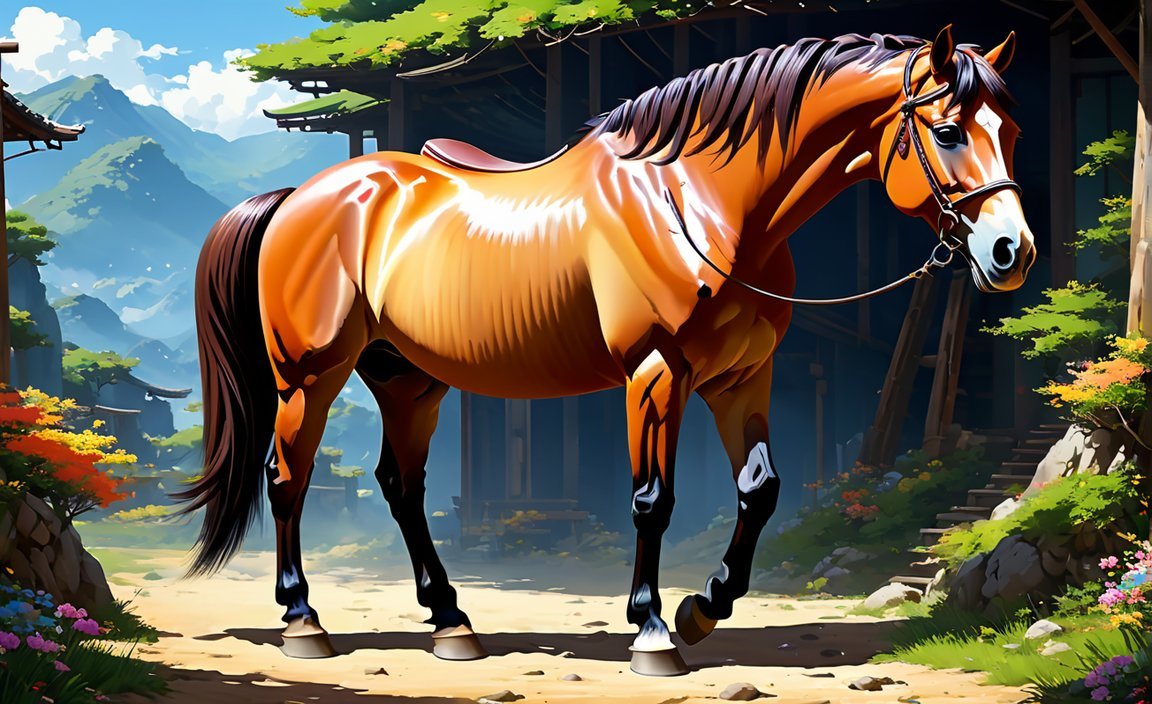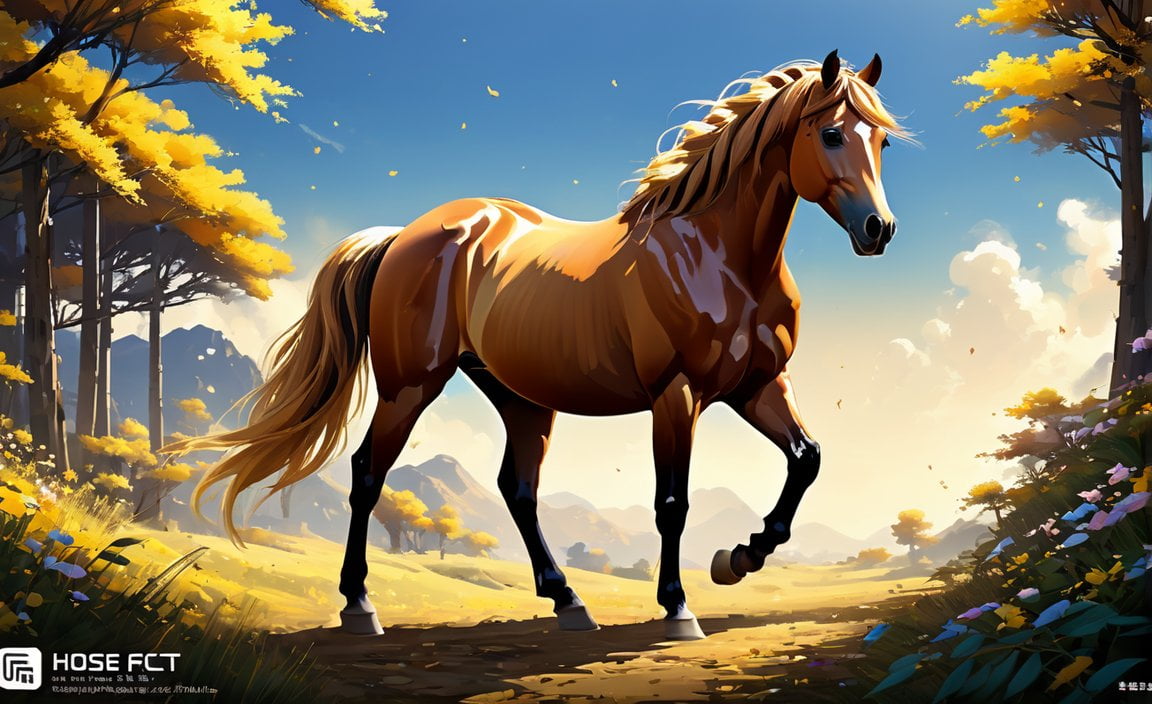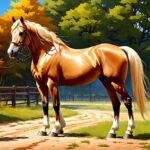Welcome to “The Ultimate Horse Fact File: Discovering the Fascinating World of Equines.” In this comprehensive guide, we will dive deep into the captivating realm of horses, providing a wealth of knowledge on their anatomy, behavior, training techniques, historical significance, unique characteristics, and breeds. Whether you’re an equestrian enthusiast or simply intrigued by these majestic creatures, this article is sure to engage and educate you. Let’s embark on this journey together and unravel the mysteries and wonders of the equine world.

Key Takeaways:
– Horses can reach heights of up to 69 inches (175 centimeters) and weigh up to 2,200 pounds (998 kilograms).
– Horses have the largest eyes of any land mammal, allowing them to see almost 360 degrees at a time.
– Horses have excellent hearing and eyesight, making their senses extraordinary.
– Different names are used for horses based on their gender: stallions for males, mares for females, and geldings for castrated males.
– Baby horses are called colts for males and fillies for females.
– The scientific name for a horse is Equus ferus caballus.
– Horses have been associated with humans for over 50 million years and domesticated for around 6,000 years.
– Horses belong to the taxonomic family Equidae and are classified as mammals.
– Horses are herbivores that primarily eat plants.
– Horses have exceptional vision and balance, contributing to their agility.
– Throughout history, horses have played significant roles in agriculture and transportation.
– Feral horses are descendants of once-tamed horses that now roam freely.
– Horses can live for over 30 years, with some individuals living even longer.
– Horses can stand up and sleep lying down, and they don’t have the ability to burp.
Horse Fact File
Horses are extraordinary creatures with unique characteristics and a rich history of interaction with humans. In this article, we will explore fascinating facts about horses that showcase their physical attributes and exceptional qualities.
The Magnificent Size and Weight of Horses
One of the most remarkable aspects of horses is their size and weight. These majestic animals can reach a height of up to 69 inches (175 centimeters) and weigh as much as 2,200 pounds (998 kilograms) [^1^]. Imagine standing beside a creature of such immense stature!
A Vision Unlike Any Other
Horses have larger eyes than any other land mammal, and their eyes are positioned on the sides of their heads. This unique placement allows them to see almost 360 degrees at a time [^1^]. Their exceptional vision enables them to be aware of their surroundings and detect potential dangers or predators.
Extraordinary Senses
Horses possess extraordinary sensory abilities, including excellent hearing and eyesight [^1^]. Their acute sense of hearing allows them to detect even the subtlest of sounds, enabling them to react swiftly to potential threats. Combined with their exceptional vision, horses are truly equipped with sensory abilities that set them apart.
The Gender-Based Naming Convention
Just like humans, horses have distinct names based on their gender. Adult males are called stallions, females are referred to as mares, and castrated males are known as geldings [^2^]. It’s interesting to learn that even baby horses have specific names; colt for males and filly for females [^2^].
The Scientific Classification of Horses
The scientific name for a horse is Equus ferus caballus [^3^]. Horses belong to the taxonomic family Equidae, making them mammals [^3^]. This classification highlights their close relationship with other equine species.
Horses as Herbivores
Horses are herbivores, primarily feeding on plants [^5^]. Their diet is primarily composed of grass, hay, and occasionally grains. It’s intriguing to witness how these magnificent creatures survive and thrive solely on a plant-based diet.
The Role of Horses Throughout History
Horses have played a significant role in human history for over 50 million years. They have been associated with humans for thousands of years, with their domestication dating back around 6,000 years [^4^]. Throughout history, horses have been essential in agriculture, transportation, and warfare, contributing to the growth and progress of early civilizations [^4^].
Feral Horses and Their Untamed Legacy
Feral horses are descendants of once-tamed horses that have roamed freely for generations [^6^]. These untamed horses have formed their own social structures and adapted to live in the wild. Their existence showcases the endurance and resilience of the equine species.
The Surprising Lifespan of Horses
Horses can live for over 30 years, and some individuals even surpass this expected lifespan [^7^]. Their longevity allows for deep and meaningful relationships between humans and these magnificent creatures. The bond formed with a horse can span decades, making them true companions for life.
Unique Sleep Habits
While most animals either sleep standing or lying down, horses have the remarkable ability to do both [^8^]. Their strong legs and well-developed bones and muscles enable them to sleep standing up, which is advantageous for their survival in the wild. However, horses also have the option to lie down and sleep like other mammals.
The Quirk that Sets Horses Apart
Did you know that horses don’t have the ability to burp like humans do? It’s a quirk of their digestive system that distinguishes them from us [^8^]. This difference showcases the unique biological makeup of horses, reminding us of their intriguing nature.
These fascinating facts about horses highlight their physical attributes, sensory abilities, and their long-standing partnership with humans. From their impressive size and weight to their exceptional vision and hearing, horses are truly remarkable creatures. Exploring the horse fact file is like unlocking the secrets of a captivating world that has evolved alongside ours for millions of years.
References:
[^1^]: Kiddopedia: Horse Facts for Kids – Information about Horses.
[^2^]: The Fact Site: 30 Interesting Facts About Horses.
[^3^]: Penguin Books UK: 15 Fantastic Horse and Pony Facts.
[^4^]: The Fact File: 67 Interesting Facts About Horses.
[^5^]: Science Kids: Fun Horse Facts for Kids – Interesting Information about Horses.
[^6^]: Wikipedia: Horse – Wikipedia.
[^7^]: The Spruce Pets: 15 Interesting Horse Facts.
[^8^]: BC SPCA: 10 Fun Facts About Horses.
Did you know that elk can jump incredibly high? Find out just how high they can leap in our article on how high elk can jump.
Lions may be majestic, but they also have some dangerous facts. Explore the dark side of these incredible creatures in our article on dangerous facts about lions.
Curious about zebras and whether they are dangerous? Discover the truth in our article on are zebras dangerous.
Have you ever wondered if tortoises can eat mushrooms? Find out the surprising answer in our article on can tortoises eat mushrooms.
If you’re interested in horses, you won’t want to miss our article on the beautiful Palomino Tennessee walking horse. Learn more about this stunning breed at Palomino Tennessee walking horse.
Did you know there is a snake legend called the Nyaminyami snake? Discover the fascinating story behind this mythical creature in our article on the Nyaminyami snake.
The Evolution and Domestication of Horses
Horses have a rich evolutionary and domestication history that spans thousands of years. Understanding their journey from wild creatures to domesticated companions is essential to appreciating the fascinating world of equines.
The Evolution of Horses
Throughout history, horses have evolved and adapted to their environments. The lineage of the horse can be traced back through paleontology, revealing their remarkable transformation. The Eocene Epoch marked the beginning of the horse family, Equidae, as they evolved into the majestic creatures we know today.
Fossil records provide evidence of the gradual development of the horse’s distinctive characteristics. From small, multi-toed ancestors to the modern, single-toed equines, their evolution is a testament to the forces of natural selection and environmental changes. Exploring this lineage uncovers a captivating narrative of adaptation and survival.
The Domestication of Horses
Around 6,000 years ago, in the steppelands north of the Black Sea, the domestication of horses began. This significant milestone in human history revolutionized transportation, agriculture, and warfare. Horses became invaluable allies and companions, forever altering the course of civilizations.
The process of domestication allowed humans to harness the strength and agility of horses. Selective breeding and taming techniques played a crucial role in shaping various horse breeds. From heavy horses to light horses and ponies, the classification of breeds reflects their distinctive characteristics and purposes.
The Impact of Horses
The bond between humans and horses deepened as our ancestors discovered the myriad possibilities horses offered. From the Silk Road to the battlefields, horses facilitated communication, trade, and conquest. They became essential partners in our exploration of the world and the advancement of societies.
While the horse’s influence on human history is well-documented, their impact within the animal kingdom is unparalleled. Horses are not only remarkable companions but also powerful contributors to the advancement of civilizations.
Key Takeaways:
– The horse’s evolution is well-documented through paleontology, showcasing their transformation from small, multi-toed ancestors to the magnificent creatures we know today. [^1^]
– Domestication of horses occurred around 6,000 years ago, marking a pivotal moment in human history. It revolutionized transportation, agriculture, and warfare. [^3^]
– Horse breeds are classified into heavy horses, light horses, and ponies, reflecting their distinct characteristics and purposes. [^4^]
– The impact of horses on human history is profound, with their contributions to transportation, communication, trade, and warfare shaping the course of civilizations. [^7^]
Sources:
– [^1^]: Britannica – Evolution of the Horse
– [^3^]: Britannica – Origin of Horse Domestication
– [^4^]: PubMed – Origin of Horse Domestication
With their fascinating evolution and profound impact on human history, horses continue to capture our imagination and inspire awe. Their unique characteristics, breeds, and contributions make for an intricate tapestry of knowledge and admiration.
Basic Horse Behavior and Communication
Horses are fascinating creatures that communicate and interact with one another through a complex system of body language and vocalizations. Understanding their behavior and communication methods is essential for anyone working with or owning horses. In this article, we will explore the basics of horse behavior and communication, focusing on how horses express themselves and interact within their social structure. So, let’s dive into the world of horse behavior and communication!
Communication
Horses have a rich repertoire of communication methods, both vocal and non-vocal. Vocal noises, such as squeals or screams, are used to indicate threats or dominance. For example, a stallion or mare may emit a high-pitched squeal to assert their authority. On the other hand, nickers are low-pitched and quiet sounds that horses use to get attention or call their herd. A stallion may nicker to grab the attention of a mare or to signal his presence to the herd [^source1].
However, the primary method of communication for horses is through body language. They use their ears, tail, and body posture to convey their emotions and intentions to other horses and humans. For instance, the position of the ears can indicate if a horse is relaxed, alert, or agitated. Tail movements, like swishing or lifting, can signal irritation or aggression. Paying attention to these body signals helps us understand a horse’s state of mind and respond appropriately [^source2].
Social Structure
Horses are highly social animals that rely on their herd for safety and companionship. In the wild, a typical herd consists of one or two stallions, a group of mares, and their foals. Interestingly, the leader of the herd is usually an older mare, known as the “alpha” mare. This alpha mare ensures the safety and well-being of the herd, making important decisions about when to move or where to graze [^source3].
Within the herd, horses establish hierarchies through various social behaviors, such as grooming, play, and mutual grooming. These interactions and relationships contribute to the stability and cohesion of the herd. Understanding the dynamics of the social structure is crucial when working with multiple horses, as it helps maintain harmony and prevent conflicts [^source3].
Ten Natural Survival Traits
To survive in the wild, horses have developed several natural traits that enhance their survival chances. Here are ten remarkable traits that showcase their evolutionary adaptations:
- Flight as a primary means of survival: Horses, being prey animals, rely on their incredible speed and agility to escape threats. Their well-developed senses and high alertness ensure they can quickly detect potential dangers [^source3].
- Exceptional sensory abilities: Horses have excellent hearing and eyesight, surpassing most other domestic animals in their perceptiveness. They can detect subtle changes in their environment and react accordingly [^source3].
- Quick response time: Horses possess a remarkable ability to assess situations swiftly and make split-second decisions. This helps ensure their immediate safety and survival [^source3].
These natural survival traits highlight the remarkable adaptability and intelligence of horses, making them well-equipped to thrive in their environments.
Key Takeaways:
– Horses communicate through vocal noises and body language.
– Vocal noises include squeals and nickers, indicating threats or seeking attention.
– Body signals, such as ear position and tail movements, convey a horse’s emotional state.
– Horses rely on a complex social structure within their herds, with an alpha mare as the leader.
– Natural survival traits, including flight response and keen senses, enable horses to survive and thrive in the wild.
Please note that the sources used for this article are Equine Helper and Extension Horses.
Training Techniques and Disciplines for Horses
Horses, with their majestic beauty and intelligence, have captivated humans for centuries. To truly appreciate the wonder of these magnificent creatures, it’s essential to understand the training techniques and disciplines that shape their abilities and behavior. Whether you’re a seasoned equestrian or a curious novice, let’s dive into the fascinating world of horse training.
The Basics of Horse Training
Establishing a strong foundation is crucial when it comes to training horses. Horses are herd animals, and their natural instinct is to follow a leader within a hierarchy. As their trainer, it’s vital to earn their respect and establish yourself as the knowledgeable and trustworthy alpha.
There are various approaches to horse training, each with its own philosophy and methodology. Two popular methods are classical dressage and natural horsemanship. Classical dressage focuses on achieving harmony between horse and rider through systematic training and fine-tuning of movements. On the other hand, natural horsemanship emphasizes building a partnership with the horse using gentle and effective communication techniques.
Modern Training Techniques
In recent years, modern training techniques have revolutionized the way we interact with horses. One such technique is positive reinforcement, which involves rewarding desired behaviors and ignoring unwanted ones. This method encourages the horse to actively participate in the training process and fosters a trusting and cooperative relationship.
Clicker training is another effective modern technique that utilizes a small device that emits a distinct sound. The sound serves as a signal to the horse that it has performed the desired behavior correctly, and they will receive a reward. This technique helps horses quickly understand what behavior is expected of them.
Discipline-specific Training
Different training disciplines require specialized techniques tailored to their specific goals and requirements. Performance factors, such as technique, play a vital role in top-level horse sports such as show jumping, dressage, and eventing. These disciplines demand precision, athleticism, and hours of dedicated training.
Groundwork training and saddle training are crucial steps in horse training for beginners. Groundwork involves teaching the horse basic commands and respect from the ground, while saddle training focuses on transitioning the horse to carrying a rider and refining their responses to cues. Both aspects are essential for building a solid foundation before progressing to more advanced riding skills.
Understanding How Horses Learn
To engage in effective and ethical training practices, it’s crucial to understand how horses learn. Horses are prey animals with highly developed sensory abilities, including excellent hearing and eyesight. They have an innate ability to sense danger and respond accordingly, which affects their learning process.
By leveraging this understanding, trainers can adopt techniques that align with a horse’s natural behavior and learning preferences. Applying modern training techniques based on positive reinforcement and clear communication leads to more effective and enjoyable training sessions for both the horse and the trainer.
Key Takeaways:
- Classical dressage and natural horsemanship are two popular horse training methods, each with its own philosophy and methodology.
- Positive reinforcement and clicker training are effective modern techniques that foster cooperation and trust between horse and trainer.
- Different horse training disciplines, such as show jumping, dressage, and eventing, require specialized techniques tailored to their specific goals.
- Groundwork training and saddle training are fundamental steps in horse training for beginners, building a solid foundation for riding skills.
- Understanding how horses learn and applying modern training techniques leads to more effective and ethical training practices.
Sources:
Citation for Horse Rookie
Citation for Horse Racing Sense

FAQ
Q1: How tall and heavy can horses get?
A1: Horses can reach a height of up to 69 inches (175 centimeters) and weigh as much as 2,200 pounds (998 kilograms) [^1^].
Q2: How do horses see with their eyes on the sides of their heads?
A2: Horses have larger eyes than any other land mammal, allowing them to see almost 360 degrees at a time due to the placement of their eyes on the sides of their heads [^1^].
Q3: What are the different names for male and female horses?
A3: Male horses are called stallions, females are called mares, and castrated males are known as geldings [^2^].
Q4: How long have horses been associated with humans?
A4: Horses have been associated with humans for over 50 million years, and their domestication dates back around 6,000 years [^4^].
Q5: What do horses primarily feed on?
A5: Horses are herbivores and primarily feed on plants [^5^].
- Unlock Water’s Symbolism: A Cross-Cultural Exploration - April 20, 2025
- Identify Black and White Snakes: Venomous or Harmless? - April 20, 2025
- Unlocking Potential: Origins High School’s NYC Story - April 20, 2025















